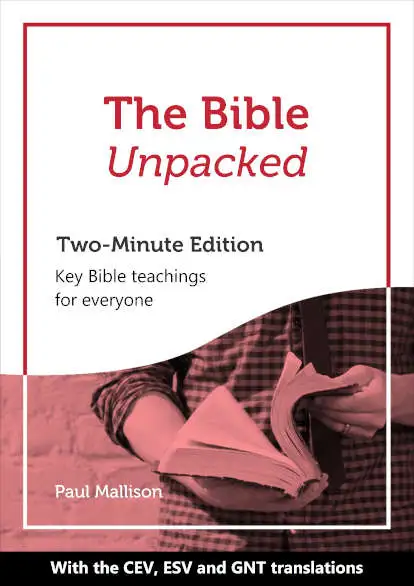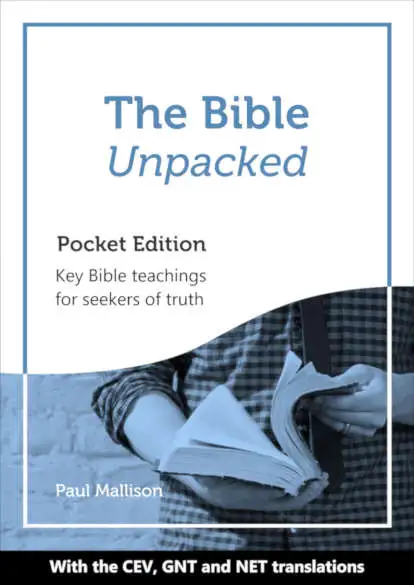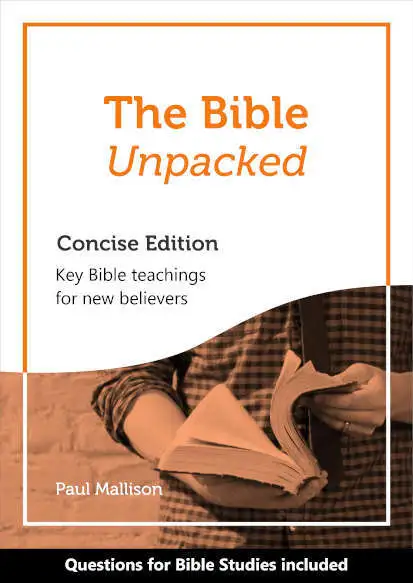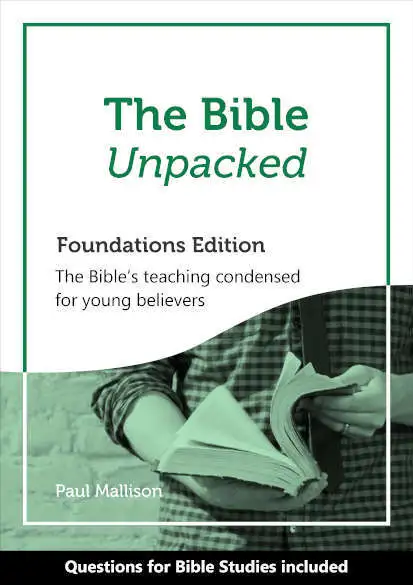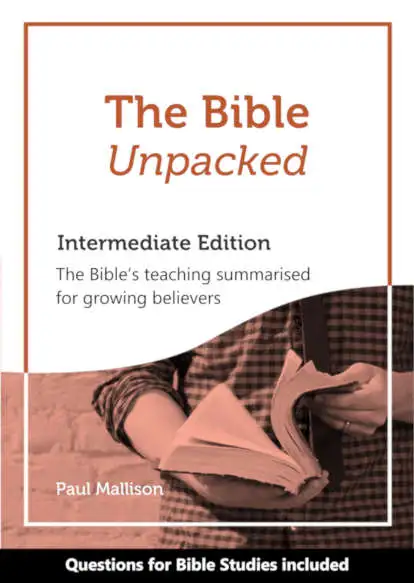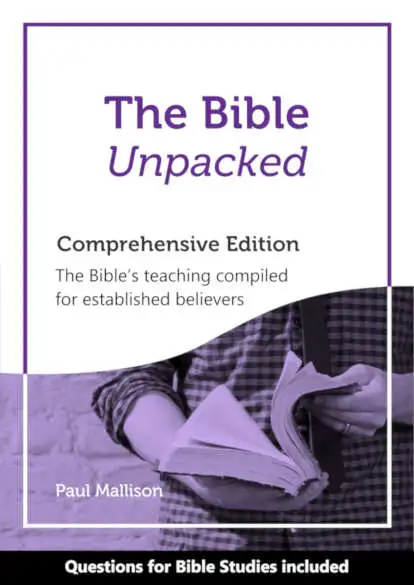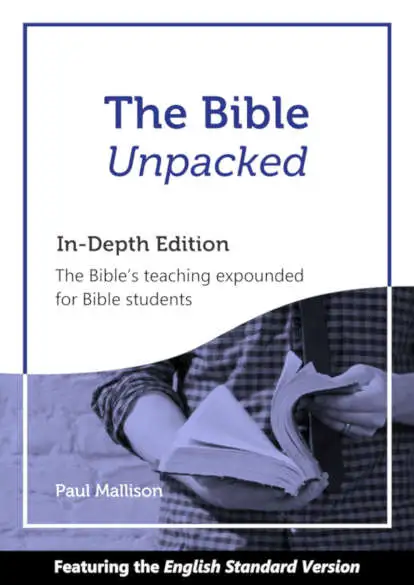tap a heading or verse.
Drag by the top bar to reposition.
Intermediate Edition
–
About ‘The Bible Unpacked’
About ‘The Bible Unpacked’
Sections
The Seven Editions
Overview
There are seven editions of The Bible Unpacked. They present the Bible’s teachings in a clear and readable order – primarily with Bible verses and headings derived from the verses. Occasionally comments are included.
The seven editions aim to address the needs of non-Christians through to mature Christians, from teenagers to adults. Four of the editions include Bible study questions.
Apart from the longest edition, each edition is an abbreviated version of the next one up in size.
Names and Audiences
The names, subtitles and target audiences of each edition are as follows.
Pocket Edition
Key Bible teachings for seekers of truth
For inquiring non-Christians or young new Christians.
Concise Edition
Key Bible teachings for new believers
For either new or young Christians. Also for giving to non-Christian friends.
Has Bible study questions. Ideal for Bible studies.
Foundations Edition
The Bible’s teaching condensed for young believers
For newer Christians, wanting a firm grounding in their faith.
Has Bible study questions. Ideal for Bible studies.
Intermediate Edition
The Bible’s teaching summarized for growing believers
For Christians wanting to develop a sound understanding of the faith. Very suitable for use as a study or a devotional tool.
Has Bible study questions. Excellent for Bible study groups.
Comprehensive Edition
The Bible’s teaching compiled for established believers
For Christians wanting a more comprehensive knowledge of the faith. Useful resource for preparing talks.
Has Bible study questions. Ideal for detailed study of topics.
The Selection of Verses
All the editions are essentially abbreviated versions of the In-Depth Edition. In that edition each subheading was derived from the common theme of the verses following it. As such, the subheadings are based on groups of verses with a common theme, rather than the verses being selected to support the subheadings.
The Basic Structure
The structure provides a practical framework for assimilating the Bible’s teachings. Apart from the Two-Minute Edition, each edition has two main divisions: What to Know and What to Do.
What to Know covers largely the same topics as a theological text. However, the topics are limited to teachings that the Bible specifically addresses.
What to Do is more like a manual or a “practical theology” text. It mainly contains directions on how to relate to God and to other people.
Further Matters To Grasp
The Structure of This Edition
This edition has the two main divisions mentioned above: What to Know and What to Do. Each of these divisions is divided into four groups of five chapters. Then each chapter is divided into two parts. Both of these parts contain major sections, which in turn contain a number of subheadings.
The subheadings give key Bible teachings. Each subheading is followed by a verse/s from which it is derived. Occasionally a heading or a verse is followed by a comment.
Verses and Context
Much care has been taken to interpret the verses both in the context of the passage that they are from and in the light of Scripture as a whole. Nevertheless, if you have doubts about the usage of a verse then:
- read the section in the Bible from which it is taken, and consider how it is used in its context. For this purpose, the Bible reference immediately preceding each passage contains a link to the passage in its chapter at biblia.com.
- consider how the verse fits in with Scripture as a whole. (For example, interpret OT teaching in the light of NT teaching.)
- read commentaries on the verse and its passage.
Bible Study Questions
As mentioned above, each chapter is divided into two parts. Towards the end of each part are a few questions (immediately before the 'Page Headings' list).
The questions are just suggested questions. Users who download the files of the online version to use off-line, can edit or delete any of these questions and/or add their own questions (in the html files that are downloaded).
Below each set of questions are hyperlinks back to the section to which the questions belong.
Abbreviations
Abbreviations for books of the Bible are standard ones.
“OT” is used for “Old Testament” and “NT” for “New Testament”.
Abbreviations denoting Bible translations are identified on the copyright notices page, at the beginning of this book. These abbreviations mostly occur immediately after Bible verses. In such cases the translation will appear as a screen tip, if the user hovers over the abbreviation.
Note that occasionally “. . .” appears at the end of a subheading and at the beginning of the following one. This indicates that the teaching in the second subheading’s verses follows on closely from that of the first.
Endorsements
Note that some of the following endorsements are for The Bible Unpacked series in general or for editions other than this one.
The author has done a great job in collecting and arranging texts under doctrinal and practical headings.
Dr Paul Barnett, Bishop and noted author
I highly recommend “The Bible Unpacked” for its use both in evangelism and helping people grow in their Christian faith.
Dr Peter Ralphs, Former Principal of Bible College of Queensland
Paul Mallison has compiled an excellent resource for the seeker through to mature Christians.
Glyn Henman, CEO of Young Life Australia
I am a big fan of the Intermediate level one. I carry it everywhere with me.
Gary Irvine, YWAM Leader
About the Author
Paul Mallison has a BA Dip Ed from Macquarie University, Sydney. He has spent most of his working life teaching students from a cross section of ages and backgrounds. In his work he has composed numerous teaching materials.
Paul is a son of best-selling Australian author and international educator, the late Rev. Dr John Mallison. He is credited with extensive work on the final draft of the last two of his father’s 20 published books.
He considers the theology of his The Bible Unpacked material to be “evangelical”. As for a statement of faith, he adheres to the Apostle’s Creed.
Paul lives in Sydney, Australia.
For more information about The Bible Unpacked, go to: www.thebibleunpacked.net
